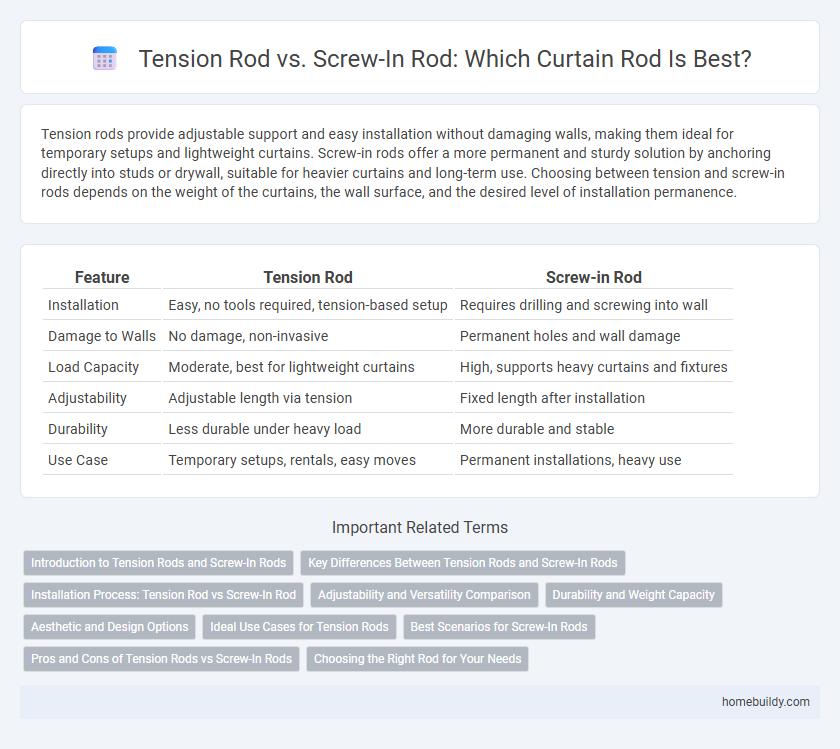Tension rods provide adjustable support and easy installation without damaging walls, making them ideal for temporary setups and lightweight curtains. Screw-in rods offer a more permanent and sturdy solution by anchoring directly into studs or drywall, suitable for heavier curtains and long-term use. Choosing between tension and screw-in rods depends on the weight of the curtains, the wall surface, and the desired level of installation permanence.
Table of Comparison
| Feature | Tension Rod | Screw-in Rod |
|---|---|---|
| Installation | Easy, no tools required, tension-based setup | Requires drilling and screwing into wall |
| Damage to Walls | No damage, non-invasive | Permanent holes and wall damage |
| Load Capacity | Moderate, best for lightweight curtains | High, supports heavy curtains and fixtures |
| Adjustability | Adjustable length via tension | Fixed length after installation |
| Durability | Less durable under heavy load | More durable and stable |
| Use Case | Temporary setups, rentals, easy moves | Permanent installations, heavy use |
Introduction to Tension Rods and Screw-In Rods
Tension rods and screw-in rods are essential hardware components used for adjustable support in various applications, such as curtain hanging and shelving systems. Tension rods rely on spring tension to stay in place without drilling, offering easy installation and damage-free mounting, while screw-in rods require fixed mounting using screws for enhanced stability and load capacity. Selecting between these rods depends on the need for temporary versus permanent installation, weight support, and surface compatibility.
Key Differences Between Tension Rods and Screw-In Rods
Tension rods utilize spring tension to hold curtains securely without the need for drilling, making them ideal for temporary or damage-free installations. Screw-in rods require mounting brackets and anchors, providing enhanced stability and weight capacity for heavier curtains or permanent setups. Key differences include installation method, load-bearing capability, and suitability for various wall types or rental spaces.
Installation Process: Tension Rod vs Screw-In Rod
Tension rods install quickly without tools by expanding between two surfaces and relying on spring tension for stability. Screw-in rods require precise drilling and anchoring, using screws to secure the rod firmly in place, which can take more time and effort. The tension rod's tool-free setup makes it ideal for temporary or adjustable applications, whereas screw-in rods are preferred for permanent and heavy-duty installations.
Adjustability and Versatility Comparison
Tension rods offer superior adjustability through easy twist-to-fit mechanisms, allowing for quick length changes without tools, making them ideal for varied window sizes and shapes. Screw-in rods, while typically more secure due to fixed installation, lack the same level of versatility as they require drilling and precise measurements before mounting. For applications demanding flexible use and frequent repositioning, tension rods provide a more adaptable solution compared to screw-in rods.
Durability and Weight Capacity
Tension rods offer greater durability due to their continuous compression design that evenly distributes stress, minimizing wear over time. They typically support higher weight capacities compared to screw-in rods, which rely on threaded connections that can loosen or weaken under heavy loads. The solid construction and absence of movable joints in tension rods make them more reliable for supporting heavy curtains or other weighty items.
Aesthetic and Design Options
Tension rods offer sleek, minimalistic aesthetics with clean lines that blend seamlessly into modern interiors, providing versatile design options without visible hardware. Screw-in rods, often bulkier due to mounting brackets, can interrupt visual flow but allow for sturdier installation in heavier curtain setups. The slim profile of tension rods makes them ideal for renters or temporary solutions seeking an unobtrusive look.
Ideal Use Cases for Tension Rods
Tension rods are ideal for lightweight applications such as hanging curtains, shower curtains, or temporary room dividers where wall damage must be minimized. Their spring-loaded design allows for easy installation without drilling, making them perfect for renters, quick setups, and adjustable spacing. Unlike screw-in rods, tension rods provide flexibility and convenience in non-permanent solutions, especially on smooth surfaces like window frames or tiled walls.
Best Scenarios for Screw-In Rods
Screw-in rods excel in scenarios requiring strong, permanent fixtures such as securing heavy curtains or dividing walls where stability is paramount. Their threaded design allows for a firmer grip in drywall or wooden surfaces, reducing the risk of slipping under substantial weight. Ideal for long-term installations, screw-in rods offer superior load-bearing capacity compared to tension rods in demanding environments.
Pros and Cons of Tension Rods vs Screw-In Rods
Tension rods offer easy installation and adjustable length without the need for drilling, making them ideal for temporary or damage-free setups; however, they may lack the stability and load-bearing capacity of screw-in rods, which are fixed securely into walls for heavy-duty support. Tension rods are lightweight and portable but can slip or lose tension over time, while screw-in rods provide long-term durability and reliability at the cost of more permanent installation. Choosing between the two depends on the balance between convenience, strength, and the nature of the mounting surface.
Choosing the Right Rod for Your Needs
Tension rods provide adjustable support through compressive force, making them ideal for temporary or damage-free installations on walls or ceilings. Screw-in rods require secure anchoring into a surface, offering a more permanent and robust solution for heavier loads or long-term use. Selecting between tension and screw-in rods depends on factors such as load capacity, installation surface, and desired permanence for optimal performance.
Tension rod vs Screw-in rod Infographic

 homebuildy.com
homebuildy.com